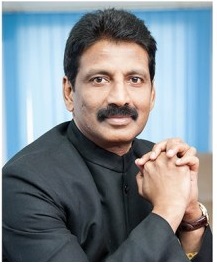SOCIAL MEDIA- A HAVEN FOR CYBER CRIMINALS

When I joined the Indian Police Service in 1991, there was no internet and therefore no type of cyber crime. Had anyone uttered the word cyber crime or Whats app back then, I would have mistaken it to be science fiction. Fast forward to today, the Internet has become ubiquitous and omnipresent. It now traverses each and every corner of this planet touching more than 3.2 billion people. The number of people who have gained access to the Internet has witnessed a seven fold increase from 6.5% of the global population in 2000 to 43% of the global population in 2015.India has over 460 million internet users today, and this figure is sure to rise to 635.8 million by 2021.There will be an estimated 358.2 million social network users in India by 2021, from the 216.5 million in 2016. The birth of the internet coupled with the formation of the World Wide Web appears to have paved the way for the evolution of the social media. The launch of Web 2.0 in 2004 which moved the static HTML to a more interactive and dynamic experience, spawned the mushrooming of social media sites all over the world. The developers of social media applications in order to make their sites popular started building innovative platforms with capabilities to deliver a better and a stronger dopamine hit to the brains of the users to keep them hooked. This made social media attractive and addictive in a nice way for family, friends and strangers to keep in touch. By luring millions of users to spend a considerable amount of time and share a great deal of information on the sites, the networking platforms were transformed into enormous repositories of data on potential victims.
Why do criminals rob banks ? Because that’s where the money is. In the same way, cyber criminals are attracted to the social media sites because they are a treasure trove of data of millions of unsuspecting victims waiting to be ripped off. Social media sites are like wads of high denomination currency notes or a pot of gold left on the sidewalk waiting to be picked up. In this case, the sidewalk is not filled with good Samaritans but by unscrupulous elements waiting to walk off with the loot. The loot available to be exploited on social media sites was estimated to be 25 billion dollars in 2013 alone.
Symantec a security solutions provider has ranked India second among nations to be targeted by cyber criminals through social media in 2014 after the United States. They also reported that India had the second-highest number of social media scams globally and the highest in the Asia Pacific region. According to the National investigating agency (NIA), every sixth cyber crime in India is committed through social media. Indian youth is the third highest number of social media users after China and the US with an estimated number of over 381 mobile phone subscriptions with Internet connectivity.
Cyber criminals find internet convenient and attractive due to the anonymity it offers as well as its ability to target countries outside their own which makes it extremely difficult for the police to enforce the law. The aspiring cyber criminals operate boldly on the belief that the law enforcement does not have the requisite capability and knowledge to operate on the online field. Terrorism, therefore, has evolved rapidly due to the ease and anonymity offered by cyberspace to propagate its ideologies, as well as to radicalise, recruit, task and train its cadres. In spite of it, cyber crime does not command the attention, the concern and the awareness other crimes elicit in our society. It is therefore imperative that the gap between reality and the law is closed as expeditiously as possible at the international level.
Cyber criminals tend to target social media with massive user bases, such as Facebook, LinkedIn, Twitter, Instagram etc A majority of current attacks have been designed on the lines of Koobface malware. The attacks leverage user information, location, and even business activities. This information is then used to spark crime in the virtual or real world. The cyber criminals by breaching users account are also able to steal authentication credentials. This information is then used discreetly to pull personal data from the user’s online friends/contacts and colleagues. A recent Stratecast study states that 22% of social media users have fallen victim to a security-related incident, and recent documented attacks support the numbers. The Pony botnet affected Facebook, Google, Yahoo, and other social media resulting in daylight robbery of more than two million user passwords. The threat of cyber attack or cyber crime can be prevented if users stay conscious and aware while using the social media platform and refrain from sharing the password with friends, colleagues or on online forms. Caution should also be the watchword while sharing sensitive information which could be hacked or compromised like debit cards/credit cards etc.
The cyber crime scenario in our country does not truly reflect the existing situation on the ground. According to the National Crime Records Bureau (NCRB), in 2016 a total of 12187 cyber crime cases were registered all over India when compared to 11331 cases registered in 2015. There was 20.5% increase in the number of cyber crime cases in 2015 over 2014 and 6.3 % increase in cases in 2016 over 2015. As far as the number of cyber crime cases is concerned, Uttar Pradesh with a figure of 2639 registered the maximum number of cases followed by Maharashtra (2380), and Karnataka (1101). Tamilnadu registered 172 cases in 2014 which dropped to 142 in 2015 and marginally increased to 144 in 2016. Among the Metropolitan cities, Mumbai with 980 cases stood first followed by Bengaluru 762 and Jaipur 532. Chennai city with 26 cases was ranked 16 among metros.
During my last assignment as Additional Director General of Crime Branch CID, a woman with tears in her eyes walked into my office and narrated how her husband had been ripped off ₹45 lakhs over Whats app, on the promise of employment in Auckland, New Zealand. In short, we detected this case and recovered a portion of the money. During this tenure, the Cyber Cell witnessed several different types of cases including a case of child pornography where the accused was detained under the Goondas Act. The point I am trying to make here is that – Tamilnadu state in matters of cyber crime is no different from rest of the world ,social media users in Tamilnadu are as vulnerable to cyber criminals as elsewhere and their susceptibility to cyber crimes such as cyber-stalking, harassment, hacking, spoofing, cheating, fraud, spamming, squatting, trespass, white collar crimes, embezzlement, spying, child pornography, cyber trafficking, identity theft, cyber-bullying etc. is no different from other places.
When it comes to maintenance of law and order, widespread adoption of social media in Tamilnadu has proved to be a double-edged weapon. On one hand the social media in Tamilnadu helped volunteers make tremendous contribution during the Chennai floods in December 2015 as well as in the aftermath of Cyclone Vardah, while on the other hand social media played a sinister role in helping expeditious dissemination of fake messages which unfortunately culminated in incidents of lynching of a few men and a spate of assaults, centred over the paranoia of child trafficking rumours in the Northern Districts of Tamilnadu. Social media seems to have turned antisocial at the hands of rumour mongers with more than 20 cases of lynching being reported in the last two months in our country. When it comes to protests, Tamilnadu recorded the highest number of agitations in the entire country. The state witnessed 20450 agitations in 2015. The advent of social media appears to have added fuel to the existing fire, by helping organisers and opposition parties congregate multitudes swiftly, easily, cheaply and efficiently – whether it be for a cause like Jallikattu or for spreading the message of revolt against the policies of the establishment. Quite obviously, social media played a crucial role in mobilising and engineering some of the major agitations here such as the protests against the nuclear power plant in Kudankulam, the hydrocarbon project in Neduvasal, Pudukottai, the Neutrino Observatory in Theni district, the Jallikattu ban throughout Tamilnadu, the Cauvery river dispute and Sterlite project in Tuticorin etc.
Tamilnadu Government is taking several measures to tackle cyber crime and defend the state against the growing menace of cyber attacks. It has decided to set up Cyber Crime Police Stations in all the districts and cities. A cutting-edge technology center called “Cyber Arangam“ has been planned to be set up at Chennai at a cost of ₹3.24 crores to help police develop cyber resilient eco-systems through synergies with the best minds available in the IT sector. The Government has recently sanctioned a Cyber cell exclusively for the Department of Vigilance and Anti-Corruption apart from the existing cyber cells at the CBCID and Chennai City Police headquarters.
In spite of the steps being taken by the Government, We have to acknowledge the challenges that exist in tackling cyber crime in our country. First and foremost challenge is the reluctance on the part of the cyber crime victims to report cases. Only 142 cases were reported in the entire state of Tamilnadu and only 26 cases were witnessed in the Metropolitan city of Chennai in the year 2016. The National Crime Agency in the UK has reported that cyber crimes have surpassed traditional crimes like burglary and car theft in UK. If the reporting of cyber cases is improved in India, the scenario of cyber cases outstripping traditional cases could be true here as well. Another disturbing factor is the extremely poor conviction rate in the few reported cases due to of lack of adequate technical expertise on the part of police officers to investigate cyber crime cases and elicit cyber evidence. Most of them lack knowledge as to how the domains and servers work. Another serious issue confronting the investigation of cyber cases is the fact that 80 per cent of the cyber crimes happen on the international servers. If a crime takes place on a Facebook server, there is nothing we can do about it, if the Facebook refuses to release the data. Before the advent of Facebook, social media site Orkut was quite popular in Brazil. Googles Orkut platform became very convenient for cyber criminals in Brazil to commit crimes ranging from child pornography to executed kidnappings and murders. When the Brazilian Court ordered Google to share the data, Google refused to co-operate citing the absence of jurisdiction. In our own country, Orkut had run into similar problems for propagating hatred. It is therefore obvious that there is a requirement to have a uniform and globally accepted Sovereignty, Governance and net neutrality. On the legal front, though India has an effective IT Act, some amendments are imperative in the Indian law to effectively support the IT Act.
If we decide to not give a damn to cyber criminals and choose to look the other way or decide not to give the importance cyber crime deserves, we would be doing so at our own peril. We should not forget the kind of havoc the ill-gotten gains of cyber crime wreaked on the city of Mumbai in 2008 during the terrorist siege by Lashkar-e-Taiba (LeT). The entire operation was funded by a Filipino hacking cell working on behalf of Jamaah Islamiyah an associate of Al-Quaeda. Millions of dollars ripped off by the cyber criminals recruited by it were channelled to their manipulators in Saudi Arabia who in turn laundered the funds to the Lashkar-e-Taiba team in Pakistan, which executed the brutal onslaught against the City of Mumbai. Ten men, armed not just with weapons but with technology such as Blackberry phones, Skype, Google Earth and GSM handsets, were able to bring a city of 12 million people, the fourth-largest metropolis on earth, to a complete impasse, in an event that was telecast live the world over. Guns and bombs are not new in terrorist operations but these operatives who accessed the power and brilliance of technology and social media were a new breed altogether. Social media and technology was their new found arsenal. They proved they were capable of collecting open-source intelligence mid-attack not just from broadcast media but also by mining the internet and social media in real time. The intelligence so gathered was leveraged to kill more people and outwit the authorities. This was in 2008, we can now imagine what the cyber criminals and terrorists would be capable in the present era of exponential technologies like artificial intelligence, 3D Printing, robotics, nanotechnology etc in case we fail to take action to rein them in?
Source from http://epaper.deccanchronicle.com/dt:19july2018/ & 20july2018
 Dr.K. Jayanth Murali is an IPS Officer belonging to 1991 batch. He is borne on Tamil Nadu cadre. He lives with his family in Chennai, India. He is currently serving the Government of Tamil Nadu as Additional Director General of Police, DVAC.
Dr.K. Jayanth Murali is an IPS Officer belonging to 1991 batch. He is borne on Tamil Nadu cadre. He lives with his family in Chennai, India. He is currently serving the Government of Tamil Nadu as Additional Director General of Police, DVAC.


